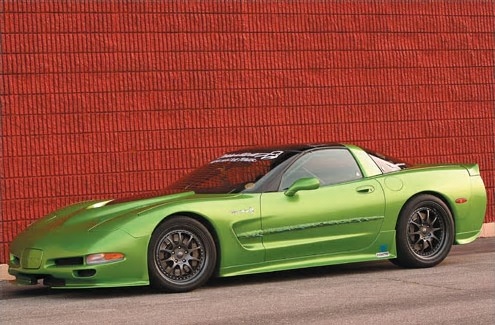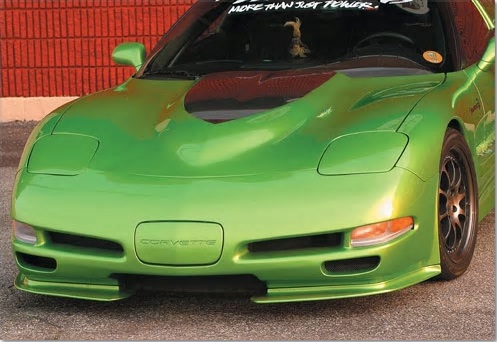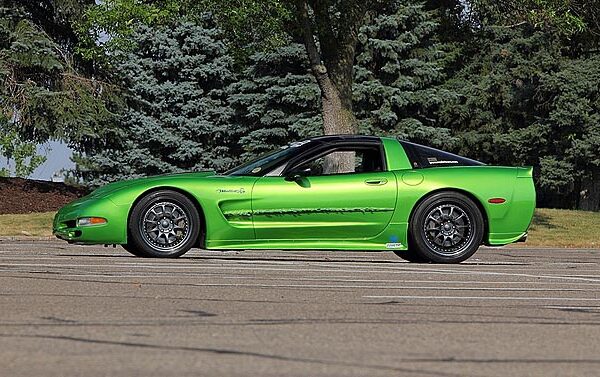A normal C5 is very easy to get in and out of, but not the Green Slime. Those sissy bars jutting from the rollcage require that you enter the cockpit butt-first and pull your legs in after you. The well-padded racing seats slide back and forth but are not adjustable in any other way. Luckily, my body build is the same as Chucks, so the rake of the seatback, the fit of the cushions, and the reach to the controls were natural for me. Even the position of the rearview mirror was right on the money.
Though equipped with all the obligatory creature comforts (climate control, audio system) it originated with, I never bothered with them for a couple of reasons: awe and more awe. They all become secondary, unessential quips that shrink into the background when the whip comes down. Reach for the steering wheel and the slim alloy Mallett shifter coincides perfectly with the height and the resistance of the pedals. The pedals are easy to heel-and-toe, and the shifter moves like grease. The idea is to make the operator as comfortable as possible and therefore completely alert when triple-digit speeds increase with the thrust of a booster rocket. In a similar but retro modification to the engine controller, Mallett has gradually staged the amount of wheelspin control to the authority of the engine package, and the action is basically invisible at low threshold. Mallett built the interior of his supercar to provide for long-distance running, but our jaunt was short enough that we couldnt appreciate or even notice the benefits.
Ride & Handling
Though our driving impression in the Green Slime was restricted to the highway, we have driven other Mallett cars on nearly every type of terrain, including gravel roads. Chucks green car is equipped with T-1 spherical rod end links, Penske double- adjustable shock absorbers, and an A-arm bushing kit. While necessarily forceful, the suspension is quite fluid and comfortable for normal driving even though it will generate in excess of 1.0 g on the skidpad. Ride quality is no harsher than that of a ZO6, but the capability is well beyond the experience of most drivers and certainly that of ordinary street encounters. This can be traced to stock Z51 spring rates coupled with shock valving that is greater than what the factory provides. (It poses 23 steps for the rebound phase, for instance.) This preserves ride quality while damping and controlling wheel movement, especially when the road gets twisty. Call it the supreme active safety device. The Green Slime wears 18×9.5 and 19×11.0-inch wheels and a Michelin Pilot tire combination specific to it.
In our trials with previous and less- powerful Mallett C5s, the tendency is for a neutral handling attitude that goes to a mild understeer condition at the limit of adhesion. The power assist is minimal, steering feel is substantial, and the feedback telegraphs through the steering wheel better than that of a ZO6. Turn-in is naturally quick and precise. Aside from the effect of the whopping big Goodyears, another key feature is the eight-point rollcage that offers passive safety, peace of mind, and the structural rigidity matched to a race-only rig. Superior traction attends superior handling characteristics. The stiffer the chassis, the better the suspension geometry is able to react, thus the wheels tend to remain upright and offer the best possible adhesion patch at all times. In all, the Corvette is a well- balanced road machine.
Drivetrain
Before explaining the engine, lets investigate the computer that controls it and the rest of the Slimes critical power functions. In a word, it is flawless. It makes the Charlie Mallett-built engine run like a champ, produce a bit less than 700 rear-wheel horsepower, and helps Mallett realize 27.5 miles per gallon on the highway. Sounds too good to be true, but it is. Perhaps the best part of this package is the machines utter driveability, a feat the factory has yet to duplicate with its own mules. Chucks car behaves just as well pottering around town as it does with the pedal to wood. Theres nary a stumble, rattle, or hiccup. It idles straight, smooth, and without any fluctuation, and throttle response is nearly telepathic. Though somewhat excitable in the wet, the Michelins plant a fat tread on dry tarmac, and you are simply gone no wheelspin, no drama.
Further, the engine purrs at idle; no overexcited cam action steals the solitude, and the exhaust stays quiet as well. At normal speed you cant even hear the exhaust pulses running into one another in the stainless steel long-tube headers. The engine runs calmly and stays under wraps, and theres only a faint whistle from the Vortec supercharger at idle. At 435ci, this GEN-III-based engine is plenty big enough to be a torque monster as well, and theres plenty of it for low-speed operation. A close-ratio M12 transaxle and a 3.42:1 ring-and- pinion fill in any minor gaps. The billet-hewn shifter jutting from the console is fashionably thin and fits the Slimes lithe image, but the linkage is precise and surely lessens the chance of notching Third gear.The bored cylinder case houses a steel stroker crankshaft and 9.2:1 custom-made slugs on forged steel connecting rods. Until the GEN-IV parts become available, the cylinder heads are CNC-ported D-port LS6 castings. Without the benefit of forced air induction, this engine (albeit with a 11.5:1 compression ratio) produces 550 hp at 5,800 rpm. When Mallett adapts and dresses the custom-built, reverse-rotation Vortech supercharger, it conjures up a wicked 15 psi of positive manifold pressure which is supported by a massive air-to-air intercooler) and blows output into the stratosphere with more than 750 hp at the flywheel. Thats efficient enough to produce a quarter-mile clock of 10.70 at 149 mph!
As tested on Power Tour, we are remiss for any witnessed performance data, but we can offer the following. At the National Corvette Museum annual C5 bash last April, Mallett entered Lazslo Hampels blown 427 Z06 (equipped with an automatic) in the competition, which includes a quarter-mile dragstrip as well as a slalom course trial. The kicker is that the car could only use one type of tire for both contests. Mallett put on some Hoosier R compound race rubber and had at it. Chuck manned the straightline runs at Beech Bend and produced a best of 11.35 at 135. Then autocross maven Tom Kloztan threaded Hampels fiberglass through the course to catch Second Place. (He grazed a few cones and was penalized accordingly.) Even though street trim was the order, the Mallett boys total exhibition was good enough to put them on top of the rest, and Lazslos car was the only one driven to the event.
Our space shot came at the end of a particularly frustrating day. Mallett offered the car at a gas stop. We were a little apprehensive. Rain had spattered the windshield all day. Under a lead gray sky, we dropped a lead foot. The Green Slime left the filling station quietly, and once we were squared away, we simply tromped the throttle and wound the engine to 5,600 because Mallett told us it was all in at 6,000, anyway. The quiet kitten made a low growl that exploded into a wonderful mechanical frenzy as the revs jumped on top of one another. We shifted calmly, and the engine pulled hard and seamless, Chuck urging us all the way.




